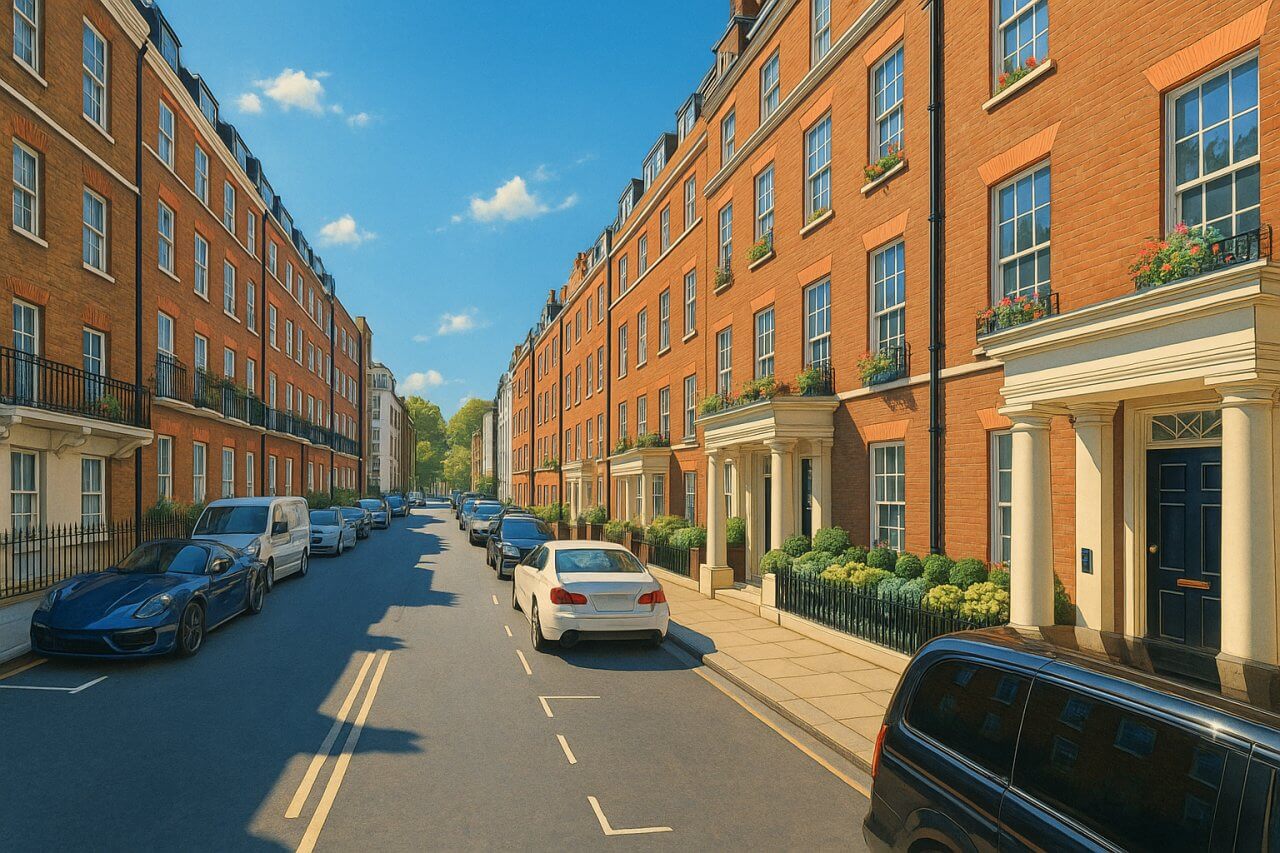
Hill Street, London
Hill Street is an elegant residential and commercial street in the heart of Mayfair, situated within the City of Westminster, London. It stretches from Berkeley Square in the east to the junction of South Audley Street and Deanery Street in the west, occupying a sought-after location near some of London’s most prestigious addresses.
Overview and Character
Hill Street exudes the classic charm of Mayfair, with its blend of period Georgian townhouses, luxurious apartments, and discreet office premises. The street is relatively quiet compared to its surroundings, offering an air of exclusivity and privacy while being mere moments from the activity of Berkeley Square and nearby commercial hubs.
The street is framed by leafy pavements and refined architecture, with many of the buildings having undergone tasteful refurbishments that preserve historic details. Residents enjoy a blend of stately red-brick facades, iron-railed balconies, and sash windows. Trees line the eastern end near Berkeley Square, enhancing the tranquil atmosphere.
Location and Surrounding Streets
Hill Street is well-positioned within Westminster, bordered by the fashionable roads of South Audley Street to the west and Charles Street and Hay's Mews to the north. To the south lies Curzon Street, another prominent Mayfair address. Berkeley Square, one of London's most famous garden squares, lies at the eastern end, connecting Hill Street with the bustle of Berkeley Street and Piccadilly.
Streets connecting to Hill Street
- Berkeley Square
- Chesterfield Hill
- Deanery Street
- Farm Street
- Hay's Mews
- South Audley Street
- Waverton Street
History and Naming
Hill Street was laid out during the 18th century as part of the Grosvenor Estate’s development of Mayfair, which transformed the area from open fields into a high-status residential district. Its name is believed to be derived from the Hill family, who had historical ties to the estate, or simply a topographical reference, although the gradient is minimal.
By the 19th century, Hill Street had become a desirable location for affluent Londoners and overseas visitors, noted in several Victorian-era address books and referenced in period literature. Many of the original buildings still stand today, albeit modernised for contemporary living.
Points of Interest Nearby
While Hill Street itself is mainly residential and quiet, it benefits from its proximity to several well-known London landmarks:
- Berkeley Square – home to fine restaurants, exclusive clubs, and the iconic plane trees believed to be among the oldest in London.
- Grosvenor Chapel on South Audley Street – an important 18th-century church still in active use today.
- The May Fair Hotel – a luxury five-star hotel nearby, popular with celebrities and dignitaries.
- Curzon Mayfair Cinema – one of the capital’s oldest art-house cinemas, located on nearby Curzon Street.
Property and Real Estate
Real estate on Hill Street is among the most expensive in London. As of May 2025, average property prices range from £1.5 million for a one-bedroom flat to over £8 million for larger apartments and penthouses1. A typical two-bedroom flat measures around 1,200 sq ft (111 sq m), while some of the grander homes and developments can exceed 3,000 sq ft (279 sq m).
Properties on Hill Street are favoured by both wealthy locals and international buyers, with many buildings offering concierge services, secure access, and underground parking. Renting a flat in the area can cost upwards of £1,200 per week, depending on size and amenities.
Transport Links
Nearest London Underground Stations
Hill Street is conveniently located within walking distance of several major London Underground stations:
- Green Park Station – served by the Jubilee Line, Piccadilly Line, and Victoria Line
- Bond Street Station – served by the Jubilee Line and Central Line
- Oxford Circus Station – served by the Bakerloo Line, Central Line, and Victoria Line
Nearby Bus Services
Multiple Transport for London (TfL) bus routes operate along nearby Park Lane, Piccadilly, and Oxford Street. The closest bus stops include:
- South Audley Street (Stop X) – served by routes 22 and C2
- Berkeley Square (Stop E) – served by routes 8 and 23
- Curzon Street (Stop F) – a short walk away, with further central London connections
Fun Fact
In the 1920s and 1930s, Hill Street was home to several members of the British aristocracy and diplomatic community. According to local lore, novelist P.G. Wodehouse is said to have modelled parts of Mayfair's geography in his Jeeves stories on streets like Hill Street and Curzon Street2.
Quick Facts
- Location: Mayfair, City of Westminster, London
- Connects: Deanery Street and South Audley Street (west) to Berkeley Square (east)
- Notable Nearby: Berkeley Square, Grosvenor Chapel, Curzon Cinema
- First Developed: 18th century as part of the Grosvenor Estate
- Property Prices (May 2025): £1.5M to £8M+; approx. 1,200–3,000 sq ft (111–279 sq m)
- Nearest Underground: Green Park, Bond Street, Oxford Circus
- Nearby Bus Routes: 8, 22, 23, C2 (various stops)
- Character: Quiet, elegant, primarily residential with historic Georgian architecture
References
- Rightmove – Mayfair Property Listings (accessed May 2025)
- British History Online – Mayfair: Development and Street Names
Map of Hill Street, London
 Painting of Hill Street, London
Painting of Hill Street, London